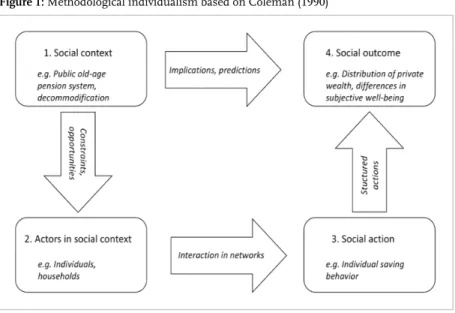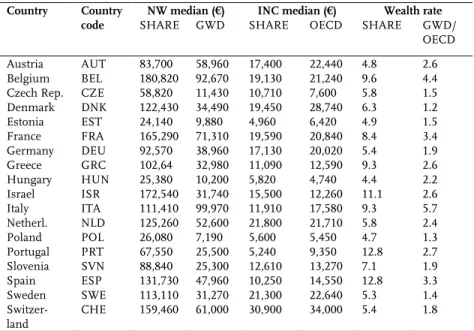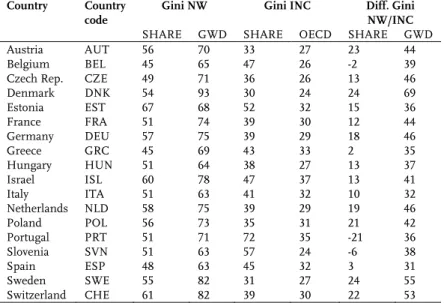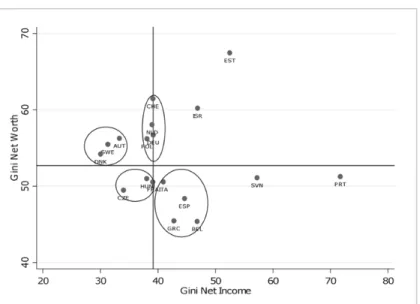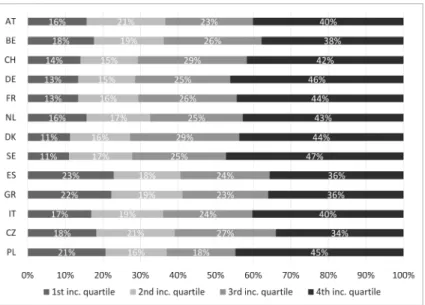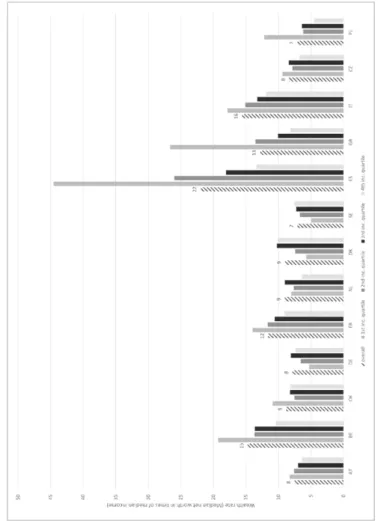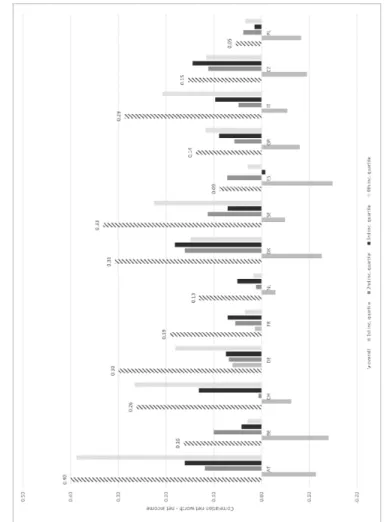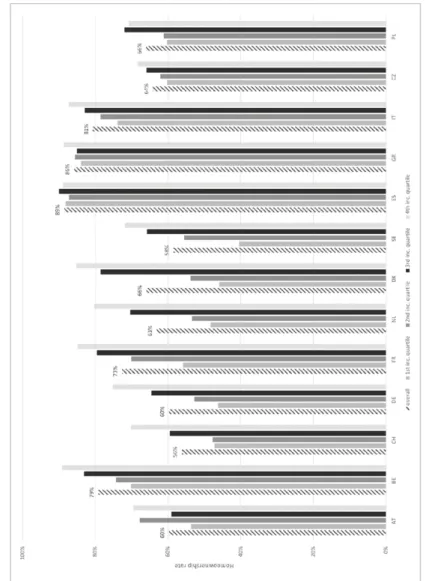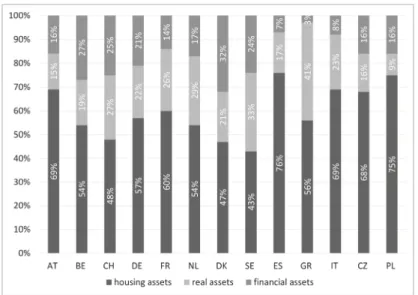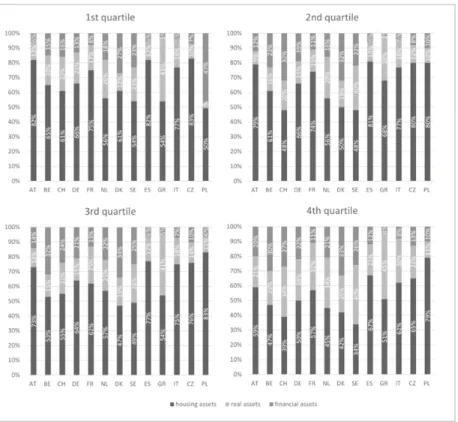14
Bamberger Beiträge zur SoziologieWealth as a Distinct Dimension of Social Inequality
Nora Skopek
Bamberger Beiträge zur Soziologie
14
Bamberger Beiträge zur Soziologie
Band 14
2015
Amtierende Herausgeber:
Hans-Jürgen Aretz, Uwe Blien, Sandra Buchholz, Henriette Engelhardt, Michael Gebel, Corinna Kleinert, Bernadette Kneidinger, Cornelia Kristen, Ilona Relikowski, Elmar Rieger, Steffen Schindler, Olaf Struck, Mark Trappmann Redaktionsleitung:
Tobias Putz
Wealth as a Distinct Dimension of Social Inequality
Nora Skopek
2015
Die Deutsche Nationalbibliothek verzeichnet diese Publikation in der Deut- schen Nationalbibliographie; detaillierte bibliographische Informationen sind im Internet über http://dnb.d-nb.de/ abrufbar.
Dieses Werk ist als freie Onlineversion über den Hochschulschriften-Server (OPUS; http://www.opus-bayern.de/uni-bamberg/) der Universitätsbiblio- thek Bamberg erreichbar. Kopien und Ausdrucke dürfen nur zum privaten und sonstigen eigenen Gebrauch angefertigt werden.
Herstellung und Druck: docupoint, Magdeburg
Umschlaggestaltung: University of Bamberg Press, Anna Hitthaler
© University of Bamberg Press Bamberg 2015 http://www.uni-bamberg.de/ubp/
ISSN: 1867-8416
ISBN: 978-3-86309-334-1 (Druckausgabe) eISBN: 978-3-86309-335-8 (Online-Ausgabe) URN: urn:nbn:de:urn:bvb:473-opus4-265529
Diese Arbeit hat der Fakultät Sozial- und Wirtschaftswissenschaften der Otto-Friedrich-Universität Bamberg als Dissertation vorgelegen.
1. Gutachter: Prof. Dr. Hans-Peter Blossfeld 2. Gutachter: Prof. Dr. Moshe Semyonov Tag der mündlichen Prüfung: 30. April 2015
The present thesis has been developed within the research project
“Household Wealth Inequality in International Comparison”, supported by the German-Israeli Foundation [PROJECT No.: I-1021-304.4/2008], led by Prof. Dr. Dr. h.c. Hans-Peter Blossfeld, Prof. Dr. Moshe Se- myonov and Prof. Dr. Noah-Lewin Epstein. This project has been con- ducted between 2010 and 2013 at the University of Bamberg and the Tel Aviv University.
First, I thank my first supervisor Hans-Peter Blossfeld, who gave me the opportunity to work in this project and strongly supported me in devel- oping my own research ideas. In case of questions and problems, he has always been a great consultant and he constantly encouraged me to pre- sent my research within an international context and to publish my re- sults in international renowned journals. I also express my gratitude to my second supervisor Moshe Semyonov, who has been a great and criti- cal commentator of the several chapters of this thesis and who made my various research stays at the Tel Aviv University very pleasant and unique. I further thank Guido Heineck, who gave me great support and feedback on my work.
Naturally, this work has benefited from a number of discussions and cooperations. Here, my special thanks goes to Oshrat Hochman, who proofed to be a great and inspiring colleague as well as a good friend. I also thank Noah Lewin-Epstein for helpful comments and Dina Maski- leyson for helping me organizing my research stays in Tel Aviv and introducing me to this wonderful city. Another person whom I owe special gratitude is Sandra Buchholz. She arouse my interest in sociolog- ical research and has always been a great supporter and critical com- mentator of my work.
For inspiring discussions and helpful comments, I express my thanks to Liliya Leopold, Jan Skopek and Bernhard Enzi. I very much appreciate the help from William Tayler with the language editing of the text. I also thank Ulrike Skopek for supporting me in various areas of life.
port.
Mannheim, June 2015
1 Preface 15
1.1 Motivation 22
1.2 Theoretical approach 24
1.3 Data source 25
1.4 Research objective and outline of the book 27 2 Setting the scene: Patterns of income and wealth inequality 31
2.1 Introduction 31
2.2 The longtime disregard of wealth in social stratification research 32 2.3 Excursion I: Four generations of comparative
stratification research 36
2.4 Excursion II: Wealth and the EGP class schema 41 2.5 Wealth and income – A semantic differentiation 47 2.6 National differences in the distribution of wealth
and the life-cycle hypothesis 50
2.7 National patterns of income inequality and Esping-Andersen’s
welfare state typology 54
2.8 Data and variables 61
2.8.1 Data 61
2.8.2 Variables 62
2.9 Analyses and results 66
2.9.1 The distribution of private wealth 66 2.9.2 National patterns of wealth and income inequality 68
2.10 Summary and conclusions 73 3 The composition of wealth: Income-rich – asset-poor? 77
3.1 Introduction 77
3.2 Theoretical considerations and previous research 79
3.2.1 The income-wealth relationship 79
3.2.2 The composition of wealth 81
3.3 Data and methods 83
3.3.1 Data 83
3.3.2 Methods 85
3.4 Results 86
3.4.1 The income-wealth relationship 86
3.4.2 The composition of wealth 90
3.4.3 The decomposition of wealth inequality 93
3.5 Conclusion and discussion 95
4 Micro-level determinants of wealth: The two dimensions of
housing inequality 99
4.1 Introduction 99
4.2 Current research and expectations 101
4.2.1 The impact of socio-economic characteristics on
homeownership rates and housing values 101 4.2.2 Linking homeownership rates to housing values 106
4.3 Data, variables and methods 107
4.3.1 Data 107
4.3.2 Variables 108
4.3.3 Methods 111
4.4 Results 113
4.4.1 Descriptive overview 113
4.4.2 Which socio-economic variables can predict
homeownership? 119
4.4.3 Which socio-economic factors can predict housing values? 123 4.4.4 Is there a relationship between homeownership rates
and housing values? 126
4.5 Conclusion and discussion 129
5 Macro-level determinants of wealth: Public pension generosity and
the distribution of private wealth 133
5.1 Introduction 133
5.2.1 The substitution effect between public pensions and
private saving 136
5.2.2 The relationship between public pensions and
private wealth inequality 137
5.3 Theoretical framework 139
5.3.1 Public pension generosity and levels of private wealth 139 5.3.2 Public pension generosity and levels of private wealth
inequality 142
5.3.3 Hypotheses 144
5.3.4 Some words on the risk of ecological fallacy 145
5.4 Data, empirical model and variables 146
5.4.1 Datasets 146
5.4.2 Empirical model and variables 147
5.5 Analyses and results 151
5.5.1 Descriptive overview 151
5.5.2 Multivariate results: Public pension generosity and
levels of private wealth 155
5.5.3 Multivariate results: Public pension generosity and
levels of private wealth inequality 159
5.6 Summary and conclusions 161
6 The consequences of wealth: Wealth and subjective well-being 167
6.1 Introduction 167
6.2 Theoretical framework 169
6.2.1 Linking wealth to SWB 169
6.2.2 Social class and SWB 172
6.2.3 Additional predictors of SWB 174
6.2.4 The comparative setting: Do different contexts imply
differences in the wealth-SWB relation? 175
6.2.5 Hypotheses 178
6.3 Data, variables and methods 179
6.3.2 Methods 182
6.4 Results 183
6.4.1 Descriptive results 183
6.4.2 Multivariate results 187
6.5 Conclusions 193
7 Conclusion and discussion 197
7.1 Main findings 197
7.1.1 National patterns of wealth inequality significantly differ
from those of income inequality 197
7.1.2 Older European households possess considerable amounts of wealth and household wealth portfolios differ across
the income distribution and across countries 199 7.1.3 Housing inequality is a two-dimensional phenomenon 200 7.1.4 Countries with more generous public pension systems
show higher levels of wealth 202
7.1.5 Household wealth is positively related to
subjective well-being 203
7.2 Contribution 204
7.3 Societal implications 206
7.3.1 The adequacy of rescue packages 206
7.3.2 Private provision for old age 207
7.3.3 Piketty: Wealth inequality and the role of institutions 208
7.3.4 The definition of poverty 210
7.4 Limitations and potential for future research 211
Appendices 215
References i
Figure 1: Methodological individualism based on Coleman (1990) 25 Figure 2: Structural levels of social inequality 29 Figure 3: Gini of income and wealth: SHARE data 71 Figure 4: Gini of income and wealth: GWD/OECD data 71 Figure 5: Percentage share of total net worth by income quartile 87 Figure 6: Wealth rate, overall and by income quartile 88 Figure 7: Correlation between net income and net worth, overall and
by income quartile 89
Figure 8: Homeownership rates, overall and by income quartile 91 Figure 9: Composition of household wealth, overall 92 Figure 10: Composition of household wealth by income quartile 94 Figure 11: The two dimensions of social stratification in housing 102 Figure 12: Percentage of homeowners in European comparison 119
Figure 13: Mean and median values of houses 120
Figure 14: Homeownership rates and housing values 127 Figure 15: Relationship between public pension generosity (net pension
replacement rate) and the level of private wealth (wealth rate:
median net worth in times of median income) 156 Figure 16: Relationship between the generosity of the public pension
system (net pension replacement rate) and the level of wealth
inequality (Gini net worth) 160
Table 1: The eleven-fold EGP class schema 43 Table 2: Median net worth (NW), median net income (INC) and
wealth rates 67
Table 3: Gini net worth (NW), Gini net income (INC) and difference
between Gini NW and Gini INC 69
Table 4: Sample size 84
Table 5: Gini decomposition by wealth component 96
Table 6: Sample size 108
Table 7: Socio-economic household characteristics, overall and by
population group 115
Table 8: Logistic regression (with robust standard errors) on the
chance of being a homeowner 121
Table 9: Linear regression (with robust standard errors) on the
logarithmized housing value 124
Table 10: Multilevel regression (with robust standard errors) on the logarithmized housing value with households (Level 1)
clustered in countries (Level 2) 128
Table 11: Net pension replacement rates (NRR) and aggregated
income (INC) and wealth (NW) measures in 40 countries 152
Table 12: Additional macro-level indicators 154
Table 13: Regression (with robust standard errors) on the level
of private wealth (wealth rate: WR) – 40 countries 157 Table 14: Regression (with robust standard errors) on the level
of private wealth (wealth rate: WR) – 30 countries 158 Table 15: Regression (with robust standard errors) on the level
of private wealth inequality (Gini net worth) – 40 countries 162
(standard deviations in parentheses) 184 Table 17: OLS regression (with robust standard errors) on GLS 188 Table 18: OLS regression (with robust standard errors) on GLS in
three groups of wealth (standard errors in parentheses) 191 Appendix A: Logistic regression (with robust standard errors) on the
chance of being a homeowner 215
Appendix B: Linear regression (with robust standard errors) on the
logarithmized housing value 217
Appendix C: Control variables 219
Appendix D: List of variables included in the analysis and
their definition 221
1 PREFACE
In recent times, the topic of wealth inequality has attracted a lot of media attention. In 2011, the two psychologist Michael Norton and Daniel Ariely published an article about a survey they conducted (Norton and Ariely 2011). In this survey, they asked a nationally representative online panel of US American citizens about their perception of the actual and about their desired level of wealth inequality in the USA. They found firstly, that respondents think that wealth is substantially more evenly distribut- ed in the United States than it actually is. While the respondents ex- pected the top quintile of the US American wealth distribution to hold 60 per cent of total net worth, in fact the authors report them to hold 80 per cent. Secondly, respondents at all income levels said that they would prefer wealth to be even more equally distributed than they expected it to be. These findings triggered a wide-ranging discussion about the societal consequences of high levels of wealth inequality.
A second study that attracted large media attention, this time especially in Europe, was the “Household Finance and Consumption Survey”
(HFCS). The first wave of the HFCS has been conducted in 2010 and 2012. In early 2013, the national central banks published first results of this survey. These results triggered a wide-ranging discussion on the adequateness of rescue packages for the financially troubled Mediterra- nean countries in the Eurozone area. The German Central Bank (GCB) results showed that “the households in bailed-out countries have more net assets than those in countries which paid out funds for the rescues”
(Reuters 2013). Most notably, in Germany, “the bloc’s paymaster”
(Reuters 2013) households possess less than a third of median net worth of those households in Italy or Spain. The GCB names the low home- ownership rate, low house prices and a high number of single-person households in Germany as compared to Italy and Spain as the main reason for these differences in levels of private wealth (Deutsche Bundesbank 2013).
Only a couple of months ago, the French economist Thomas Piketty (2014) published an English version of his book “Capital in the Twenty- First Century” (the original French version was published in 2013 under the title “Le Capital au XXIe siècle”). In this book, the author focuses on
wealth and income inequality in Europe and the USA since the 18th century. The argumentation of the book is based on the formula r>g, derived from economic growth theory, which states that over the long run, the rate of return on capital (r) is greater than the rate of economic growth (g) meaning that wealth grows faster than economic perfor- mance, which means that inherited wealth will grow faster than earned wealth. Thus, capitalism leads to extreme inequalities in wealth that can cause discontent and undermine democratic values, unless these ine- qualities are offset by political forces. This publication caused a lot of critical feedback, regarding Piketty’s theoretical argumentation (e.g.
Bofinger 2014; Rogoff 2014; Sinn 2014), as well as the database he used for his empirical analyses (e.g. by Giles 2014). Due to the large impact of this book, I will give a more detailed overview of Piketty’s main argu- ments and findings, but also on the main points of critique of his work here. In my conclusions section, I will then discuss my findings in the light of Piketty’s work.
Piketty’s book is a collection of extremely rich and informative work on the role of personal wealth and inheritance for economic inequality. His detailed description of the distribution and concentration of wealth starts in the eighteenths century covering all continents, with comprehensive information for France, UK, USA, Germany, Canada and Sweden. With this book, Piketty is continuing the extensive work on the concentration of income, which he conducted in the past, documented in a number of journal publications (e.g. Piketty and Saez 2003; Atkinson, Piketty, and Saez 2009; Atkinson and Piketty 2007; Atkinson and Piketty 2010). In
“Capital in the Twenty-First Century” Piketty expands his perspective to a much broader topic: an analysis of capitalism.
The book consists of four parts, divided into 16 chapters. The first part (“Income and Capital”) lays the foundation for the following parts and consists mainly of basic ideas, among them definitions and important relationships, which are repeatedly used throughout the book. The sec- ond part (“The Dynamics of the Capital/Income Ratio”) focuses on the long-run evolution of the capital-income ratio as well as the functional distribution of national income, differentiating between labor income and capital income. The third part (“The Structure of Inequality”) is an
analysis of inequality and distribution of wages, property income and wealth at the individual level. Moreover, Piketty describes the historical dynamics in inequalities in income and wealth. This part finishes with prospects for the global distribution of wealth. Finally, in the fourth part (“Regulating Capital in the Twenty-First Century”), Piketty derives nor- mative lessons and policy implications from the findings of his book.
The main objective of Piketty, though not stated by himself, “is nothing less than a unification of growth theory with the theories of functional and personal income distributions, and thus a comprehensive descrip- tion of capitalist economy” (Milanovic 2014: 520). The similarity of Piket- ty’s book to the work of Marx is not by chance. In the tradition of the classics of economics like Marx, Malthus or Ricardo, Piketty develops a model of the capitalist economy which he then uses to describe and explain the past and present and, most importantly, to predict the future.
Piketty’s model comprises one definitional relationship, two fundamen- tal economic laws of capitalism (termed so by Piketty himself), and one inequality relationship (cf. Milanovic 2014).
The definitional relationship links the stock of capital (K) (or wealth) to the flow of income (Y): K/Y=β. The ratio between K and Y is termed β (Piketty 2014: 50f.). Based on historical data from France, the United States and the United Kingdom, Piketty states that β until today has followed a U-shaped pattern (Piketty 2014: chapter 3; Milanovic 2014).
While it was on a very high level before the First World War, it decreased throughout the First and Second World War for about 50 years and is increasing again for the last 30 years, with a level coming close to the one before the First World War. Piketty goes on to claim that the U- shaped pattern of β is a process all advanced capitalist economies go through. This finding becomes even more significant when β is linked to Piketty’s first economic law of capitalism and his inequality relation- ship.
The first fundamental law of capitalism states that the share of capital incomes in total national income (α) is equal to the real rate of return on capital (r) multiplied by β (Piketty 2014: 52f.): α=rXβ. This relates to Piketty’s inequality relationship (“the fundamental force for divergence”, Piketty 2014: 25), stating that the return on capital (r) remains perma-
nently above the rate of growth of the economy (g): r>g. This relationship he derives from historical data. Although, he is aware of the fact that the force for “divergence is not perpetual and is only one of several possible future directions for the distribution of wealth” (Piketty 2014), this ine- quality relationship is the lynchpin of Piketty’s model of capitalist econ- omy. At the same time, it is the most controversial one. Applying this relationship, α increases by definition. In combination with the increas- ing β, the share of capital income in national income is moving towards one (Milanovic 2014). This is a self-reinforcing process. If α increases, capital owners become richer and, assuming that they do not directly consume their capital gains, they have more capital for reinvestments, which in turn leads to a further increase in r over g and thus leads to a further increase in β (cf. Milanovic 2014: 522). If we accept it as a fact that β is rising in advanced capitalist economies, and if we accept Piket- ty’s laws and definitional relationships, then in the future, the distribu- tion of national income will change in favor of capital income and the personal income distribution will become even more unequal.
The second fundamental law of capitalism refers to the long-run deter- mination of the capital/income ratio β and is derived from basic growth theory. It claims that β in the steady state is equal to the savings rate (s) divided by the rate of growth of the economy (g): β=s/g (Piketty 2014:
166). This means that if a country saves a lot but grows slowly (as can be observed in advanced capitalist economies), it will accumulate a huge stock of capital in disfavor of labor income in the long run, which in turn will result in ever increasing inequalities in both, income and wealth.
Due to Piketty’s understanding, modern capitalist societies are thus inevitably moving towards increasing wealth inequality.
In his last chapter, Piketty gives a number of suggestions to dam up the wealth inequality run based on the inequality relationship r>g. He claims, that the only way to reverse this relationship – under the as- sumption that g is exogenously given – is to reduce r (cf. Milanovic 2014:
532). Most controversially discussed, Piketty suggests a global wealth tax (combined with an increase in income tax progressivity and estate taxa- tion), being aware of the fact that this is a utopian idea. If a subset of all countries introduces such a tax, the outflow of capital to other countries
is the logical consequence. Thus, it will only work through international collaboration, which is very unlikely, as long as there exists a meaningful number of countries profiting from the “opacity of financial transac- tions” (Milanovic 2014: 532). In addition to this, emerging market econ- omies will be very unlikely to implement such a wealth tax. Milanovic (2014) however claims that Piketty’s suggestion is not completely utopi- an. He states, for example, that in most countries, the introduction of a wealth tax would be rather easy in technical terms, as housing wealth but also inheritances are already taxed in a reasonable number of coun- tries for quite some time. An expansion to the other forms of capital should therefore not be too difficult, as the market value of most capital forms is easy to ascertain and the owner is easy to identify (Milanovic 2014: 532).
Piketty’s book caused many controversial discussions. Most of the cri- tique he received for his inequality relationship r>g. Piketty’s whole model depends on the validity of this argument. Based on his historical data, Piketty claims that r has been mostly stable during the last two centuries, although the K/Y ratio was not (Milanovic 2014: 525). Two major points of critique have been raised here. The first claims that Piketty’s inequality relationship is actually not supported by the data.
The second claims that the inequality relationship is running against the fundamental laws of economic theory.
As to the first point of critique, Milanovic (2014: 527) optimistically un- derstands the inequality relationship, which is dependent on the stability of r in times of capital deepening, “as an empirical proposition whose accurateness will be confirmed or not by future developments”.
Acemoglu and Robinson (2014) are much more critical claiming that the assumption that the level of inequality is actually linked to r and g is not clearly supported by the data. Using cross-country panel data, Acemoglu and Robinson (2014) cannot find evidence for a significant relationship between r and g on the one hand and the level of inequality on the other hand.
Regarding the second point of critique, Milanovic (2014: 526) claims that Piketty’s inequality relationship, though the empirical evidence he pro- vides as well as his argumentation are persuasive – might oppose one of
the fundamental laws of economics, namely the law of decreasing re- turns to an abundant factor of production (i.e. the law of diminishing returns). The inequality relationship strongly depends on the relative stability of the rate of return on capital in the face of capital deepening. If for some reason r equals g, then Piketty’s whole model would fail.
Acemoglu and Robinson (2014) claim that there exist a number of cases, where the capital interest rate needs not exceed the growth rate. These are economies with an exogenous saving rate, with overlapping genera- tions, or with incomplete markets. Only in economically efficient econ- omies will r exceed g, which is however a question to be answered em- pirically. Davies (2015: 158) joins the critique about the inequality rela- tionship, blaming Piketty for not taking into account countervailing factors to the inequality relationship. He strongly advices taking into consideration the micro foundations of wealth inequality. As an exam- ple, he mentions that generous public pensions, health insurance, as well as other state benefits might have reduced the need for private sav- ing for a large share of the population, contributing to both the decline in wealth inequality in the 1970s and its rise thereafter. The recently growing importance of private provision shall increase private savings especially in parts of the population who have not saved before and might in turn “act as a brake on rising wealth inequality”.
Related to this critique, Krusell and Smith (2014: 3) criticize Piketty’s second fundamental law of capitalism. They state that Piketty’s formula – β=s/g – is not consistent with the textbook model of growth theory where β=s/(g+δ), with δ being the rate at which capital depreciates. Ap- plying the latter formula, if growth decreases, the capital output ratio would increase, but not substantially; and, when growth falls to zero, β would not become infinite (mathematically) or 100% (economically) (Krusell and Smith 2014: 3). In Piketty’s version of the formula, they demonstrate that if growth approaches zero, then the aggregate saving rate shall be 100% of GDP each year, which is highly implausible. The authors go on to compare Piketty’s model to a standard, alternative theo- ry – the optimal saving theory. Applying aggregate data from the US, they find the data to disagree with Piketty’s assumption, much more supporting the optimal saving theory. Krusell and Smith (2014: 2) close with suggesting that future developments of other determinants of
wealth inequality, like educational institutions, skill-biased technical change, globalization, and changes in the structure of capital markets, might be much more fundamental for a change in wealth inequality. An argument similar to the one of Davies, mentioned above.
Although Piketty’s book is very much related to the topic of my thesis, there are some important differences, which I like to highlight here.
Firstly, our research aims are completely different. While Piketty is in- terested in an analysis of capitalism, formulating general laws to diag- nose and predict levels of wealth inequality, my interest is much more of a descriptive nature. My main research motivation is to find theoretical support and empirical evidence for the establishment of wealth as a distinct dimension of social stratification. This I will do through describ- ing and analyzing the determinants, dimensions and consequences of wealth (inequality) and differentiating them from those of income. Sec- ondly, while Piketty’s work is a historical study, my work is a pure con- temporary study of the current distribution of wealth. The third differ- ence refers to the data we use. While Piketty makes use of fiscal data, I use survey data. Related to this is the fourth difference, our understand- ing of wealth inequality. Piketty argues that the best way to understand wealth inequality is to look at the concentration of wealth, focusing on (the top) wealth shares. He even goes as far as to explicitly condemn the use of the Gini coefficient, which due to Piketty gives an abstract and sterile view of inequality and has no intuitive meaning. Although fiscal data has some undeniable advantages, but also disadvantages, as com- pared to survey data, I agree with Milanovic (2014), that abandoning the use of survey data and the use of the Gini coefficient is not a good solu- tion and can lead to misleading results. A sole focus on the top wealth distribution does completely ignore the middle and the bottom of the distribution and is thus not well-suited for understanding the nature of inequality (Acemoglu and Robinson 2014). This is demonstrated by Acemoglu and Robinson (2014). By comparing two countries, which show similar concentrations of wealth (referring to the top 1% of the wealth distribution), but differ a lot in their institutional frameworks and historical backgrounds, namely Sweden and South Africa, they show that the distributions of wealth in these countries differ a lot as well. In my study, I solely focus on survey data, which can be explained by my
specific research interest. In contrast to Piketty, I am interested in the whole distribution of wealth. Trying to understand the nature of wealth inequality, it is essential for me to understand what happens at the bot- tom, the middle and the top of the wealth distribution. Fiscal data is by definition filed by a selective share of the population: those who pay taxes. Moreover, those who pay taxes might have a strong incentive to underreport their assets. Finally, taxes are not paid by individuals, but by fiscal units, who might change with changing laws of taxation (cf.
Milanovic 2014). In the light of these problems, I opted to work with survey data as a more appropriate data source for my certain research interest.
Finally, as a sociologist, I have a “natural” interest in the role of institu- tions. Responding to the critique of Davies (2015) and Krusell and Smith (2014), as explained above, but also Acemoglu and Robinson (2014), blaming Piketty for his ignorance of institutions, in my thesis, I discuss and analyze the role of institutions for the evolvement of inequalities in wealth, most explicitly so in chapter 5. Considering the role of institu- tions, I am also referring to Myles and Myers (2007) who claim that a major strength of the sociologist perspective for the analysis and under- standing of social inequality, compared to the economic one is the con- sideration of the role of organizations and institutions.
Besides the public attention of the wealth topic these three studies at- tracted, at the same time, they clearly indicate to the need for substantial wealth research. Many basic questions are still unresolved. For example, it is still not clear how wealth is distributed across countries and in how far this distribution resembles the distribution of income. Further, there is very little information on the composition of wealth, the meaning of wealth inequality in terms of social inequality, as well as the determi- nants and the consequences of wealth. With the present thesis, I aim to provide an answer to at least some of these questions.
1.1 MOTIVATION
Social stratification research until now has had an almost exclusive focus on inequalities solely deriving from the labor market, especially occupa- tional status and income. These measures, however, represent only one
dimension of individuals’ socioeconomic position (Spilerman 2000).
They are essential mainly for the working population, and may therefore paint a one-sided or even inaccurate picture of social stratification and social inequality. The central role of wealth (understood as the value of nonhuman assets net of debts) in the process of social stratification has been largely neglected by sociological research in the past decades, which is a serious pitfall. As compared to income, wealth shares im- portant characteristics, making it a more comprehensive measure of economic well-being. Income – as a cash-flow – is restricted to a certain point in time or minor time interval. In addition, income is generally restricted to times of labor market activity. Wealth – as a stock figure – is accumulated throughout the whole life-course. While income thus re- flects an entity's short-term consumption level, wealth is better able to capture its long-term consumption potential, which is “the capacity [...]
to maintain a particular standard of living” (Spilerman 2000: 497). In contrast to earned income that demands investment of time, effort, and working ability from individuals, wealth offers access to capital and goods independently of individual investments and abilities (Elmelech 2008). This has also implications for the understanding of poverty: while income poverty may often only last for shorter periods of time in a job career, poverty in wealth tends to be a long-term state in the life course (Elmelech 2008). In addition, wealth can be transferred across genera- tions, which can result in a perpetuation of wealth inequalities. Studying the distribution of wealth, as well as its sources, determinants and con- sequences is thus significant for an understanding of social stratifica- tion.
Despite the relevance of wealth for the process of social stratification, both, theoretical and empirical wealth research has almost exclusively been conducted in the field of economics for a very long time (e.g.
Atkinson 1971; Davies and Shorrocks 2000; Gale and Scholz 1994; Lydall and Lansing 1959; Wolff 1996). The same, however, holds true for the broader issue of explaining economic inequality (i.e. the basic sociologi- cal question of “Who gets what and why?”) (Myles and Myers 2007).
Sociologist have remained almost silent on this issue in the last decades, being preoccupied with the question of “What determines individual attainment?” (Kenworthy 2007). This is very unfortunate, as sociology
can make important contributions to the study of wealth and economic inequality. Among the generic contributions sociology can make to the explanation of cross-national differences in household or family wealth1 are the role of family dynamics and family demographics; the role of power; and the role of organizations and institutions (cf. Myles and Myers 2007: 581).
Very recently though, also sociology has become interested in studying wealth (e.g. Elmelech 2008; Keister and Moeller 2000; Kurz and Blossfeld 2004; Semyonov and Lewin-Epstein 2011; Spilerman 2000;
Torche and Costa-Ribeiro 2012). So far, sociologists agree that wealth has to be treated as an additional dimension of economic well-being and socio-economic status, as income and wealth show only weak correla- tions (Keister and Moeller 2000; Spilerman 2000). Consequently, socio- logical scholars argue that neglecting wealth in the study of inequality would tell only parts of the social stratification story (Keister and Moeller 2000; Spilerman 2000; Elmelech 2008). The motivation of this thesis is to make a sociological contribution to the study of social stratification in terms of wealth.
1.2 THEORETICAL APPROACH
In general, my scientific work is based on the principle of methodologi- cal individualism. Although some chapters convey a strong macro- sociological perspective (e.g. chapter 5), I always understand social phe- nomena (e.g. levels of wealth inequality) as resulting from the motiva- tions and actions of individual agents. I understand the individual ac- tions and motivations, which result in social phenomena as being shaped by social institutions, norms and, structures. This is especially reflected in chapters 5 and 6. In these chapters, I analyze the impact of different institutional contexts (specifically, differences in public old-age pension systems) on the distribution of wealth (chapter 5) as well as the relationship between wealth and subjective well-being (chapter 6). My
1 Myles and Myers (2007) actually refer to the study of economic inequality in terms of income. As an additional dimension of economic standing, alongside income, the same however applies to the study of wealth and wealth inequality.
theoretical approach is illustrated in Figure 1, which is based on the popular ‘Coleman boat’ (Coleman 1990), linking macro states and out- comes on the societal level with the logic of individual-level action.
1.3 DATA SOURCE
In general, there exist two major sources of wealth data: survey data and tax data (wealth taxes and estate tax data). Each type shares some ad- vantages as well as disadvantages. Problems of survey data are sampling- and non-sampling-errors. As the distribution of wealth is highly skewed, levels of inequality are likely to be underestimated. This issue can be solved, however, by oversampling the top wealth deciles, which is done by many surveys.
Figure 1: Methodological individualism based on Coleman (1990)
Note: Own illustration.
Typical non-sampling-errors in wealth surveys are item- and unit- nonresponse as well as mis- and underreporting, which are typical prob- lems of questions addressing financial aspects. Problems of item- nonresponse are normally tackled by applying a multiple imputation strategy for filling in missing values. Item-nonresponse is most likely to
appear for financial assets, and least likely to appear for housing values (cf. Davies 2011: 129). To correct for problems of unit-nonresponse, many surveys provide weights that correct for the low response rates, which are very often observed among the very poor and the very rich. In surveys, as compared to tax data, financial wealth has been found to be usually underreported, while values for real assets, particularly owner- occupied housing are normally very well reported.
In addition to the problems I already described above, the most severe problem of official tax statistics data is, that it neither captures foreign wealth nor can it fully account for the wealth of large family firms (be- cause of their entrepreneurial activity, they pay only low taxes) which is also likely to result in an underestimation of first, the level of wealth and second, the level of wealth inequality. The data I use for my empirical analyses is mostly survey data, as will be described in the following.
Most of the empirical analyses presented in chapters 2-6 are based on the “Survey of Health, Ageing and Retirement in Europe (SHARE)”. The SHARE is an international, representative panel study of the population aged 50 years and older. It is one of the very few surveys that provide detailed and internationally comparable information on the financial and housing situation of private households. Respondents are private persons aged a minimum of 50 years (targets persons for the first wave were individuals born in 1954 or earlier) and their spouses (regardless of their age) living in the same household.
Studying the distribution of wealth within the population segment of households that have either already entered retirement or are close to it allows me to investigate to what extent individuals have been successful in accumulating wealth over their life course. Nevertheless, it is a non- random fraction of the overall population and does thus not allow me to draw conclusions on the countries’ overall population. For this reason, I make use of a second wealth data source in chapters 2 and 5. I derive aggregate-level data on the levels of private wealth and wealth inequality from the “Global Wealth Databooks” (GWD) published by the Credit Suisse Research Institute (2010, 2011, 2012, 2013). With these data books, the Credit Suisse Research Institute aims to provide the best available estimates of private wealth holdings for the world’s 216 coun-
tries for the period since the year 2000. The wealth data presented in the GWD is derived from a variety of different sources, among them house- hold balance sheet (HBS) data2, survey data and “Rich Lists” (to derive an oversampling of the upper wealth tail). Unlike SHARE, the unit of analysis in the GWD is individuals, not households. The wealth measures of the GWD refer to individuals aged 20 or above. The usage of different data sources enhances the reliability of my results.
1.4 RESEARCH OBJECTIVE AND OUTLINE OF THE BOOK
The main research objective of the present thesis is to contribute to a broader understanding of social inequality by going beyond inequalities solely derived from the labor market and find theoretical support and empirical evidence for the establishment of wealth as a distinct dimen- sion of social stratification and, more importantly, of social inequality.
With social stratification, I am referring to the relative social position of individuals in a given social group, or other social unit. Social stratifica- tion becomes social inequality if access to these positions is unequal and if these positions are systematically related to advantageous or disadvan- tageous conditions of acting and living (Solga, Berger, and Powell 2009:
15). In the course of my thesis, I will show that both these conditions apply to wealth: first, access is unequal and second, being of higher (lower) wealth is related to advantageous (disadvantageous) conditions of living.
My thesis consists of five empirical studies that are knotted together by the common conception of wealth as a distinct dimension of social ine- quality. In order to find empirical support for this argument, in each study, I will approach the topic of wealth, or wealth inequality, from different perspectives. All studies represent theory-driven empirical analysis and are designed as international comparative studies. Each chapter contains specific information about the state of research, a theo- retical framework, detailed information about the applied datasets as
2 HBS data is usually a combination of survey and other data (Credit Suisse Research Institute 2010: 7).
well as information about its contribution to social stratification re- search.
By describing and comparing country patterns of income inequality to those of wealth inequality, chapter 2 sets the scene for the following chapters. In a first step, I formulate theoretical arguments, why wealth has to be treated as a distinct dimension of social stratification alongside income, and, as a distinct dimension of social inequality. In this context, I also present a detailed definition of wealth by differentiating it from income. In the empirical part of this chapter, I describe national distri- butions of wealth and compare national patterns of wealth inequality to those of income inequality in 17 European countries and Israel.
Important for the analysis of social inequality in terms of wealth, howev- er, is not only the distribution of wealth, but also the composition of wealth, as different types of assets are not only related to different ad- vantages and disadvantages in terms of consequences of wealth, but can also inform about different sources of wealth (cf. Elmelech 2008: 60).
The composition of wealth – with a particular focus on the distribution of owner-occupied housing as the quantitatively most important compo- nent of household wealth in most countries – I analyze in chapter 3. In this chapter, I also take a closer look at the income-wealth relationship, and I perform a decomposition analysis, in order to establish whether each particular wealth component has an equalizing or disequalizing effect on overall levels of wealth inequality.
If wealth is a distinct dimension of social inequality alongside income, this means that wealth not only has different characteristics than in- come, but also that wealth – and wealth inequality – and income – and income inequality – can differ in their sources (life-cycle wealth vs.
transferred wealth) and determinants (e.g. education or ethnic origin), as well as in their consequences (e.g. differences in educational attainment, in health or in subjective well-being) (see also Figure 2).
Figure 2: Structural levels of social inequality
Note: Own illustration based on Solga et al. (2009:17).
Chapters 4-6 are dedicated to the determinants and consequences of wealth. Restricted to the data available today, I can unfortunately not empirically analyze the sources of wealth.
Chapter 4 focusses on owner-occupied housing, as the quantitatively most important component of household wealth in most countries. It sets the focus on micro-level determinants of wealth and wealth inequal- ity. Moreover, it understands housing inequality as a two-dimensional phenomenon and explores the relationship between these two dimen- sions of housing inequality, homeownership rates and housing values.
Doing this, it, however, also considers a macro-level determinant of wealth. In my empirical analyses, I study homeownership rates and housing values across 13 European countries.
Chapter 5 addresses the macro-level determinants of wealth. This chap- ter studies international differences in public pension systems as a de- terminant of international differences in, firstly, levels of wealth and, secondly, levels of wealth inequality. These relationships are studied across the 34 OECD and 6 non-OECD countries.
Finally, chapter 6 examines the consequences of wealth by analyzing how an individual’s position in the distribution of wealth influences his or her subjective well-being (SWB). This relationship is studied across three countries (Germany, Israel and Sweden); representing three dif- ferent types of welfare state in order to additionally consider the possibil- ity that macro-level factors might shape the influence of wealth on SWB.
Just as chapter 4, it thus integrates the societal micro- and macro-levels.
In the Conclusion, I summarize and discuss the main findings of this thesis. By formulating intriguing questions that arise from my analyses, it provides an outlook on the potential for future research on wealth as a distinctive dimension of social inequality.
2 SETTING THE SCENE:PATTERNS OF INCOME AND WEALTH INEQUALITY
A slightly different version of this chapter has been published in International Journal of Comparative Sociology (Skopek, Buchholz, and Blossfeld 2014).
2.1 INTRODUCTION
Describing social inequalities, explaining how they come into being, and elaborating their impact on individual life chances, class identification, and political behavior has been at the core of sociology since its very inception. International comparative research on social inequality has shown that modern societies exhibit very different and distinct patterns of inequality, and that its level and persistence depend strongly on na- tional institutional settings. The work of Esping-Andersen (1990, 1999) has had a particularly strong influence on today’s understanding of how specific national institutions – above all, the level of public commitment to equal opportunities through elaborated welfare arrangements and concepts of social solidarity – shape social inequality structures. In this respect, past research (Buchholz et al. 2008; Brady 2005) has shown that the so-called social democratic welfare regime of Scandinavia seems to be especially effective in reducing social inequalities by prioritizing pub- licly supported (full) employment, high taxation of incomes, and a com- paratively high level of decommodification3. Most studies within this field, however, consider social inequalities fundamentally in terms of inequalities deriving from the labor market (especially in terms of in- come inequality), while neglecting the relevance of wealth in the stratifi- cation process. The few empirical studies conducted until now which have analyzed the relationship between income and wealth were able to show that the correlation between the two measures is much weaker than one might expect; it has been found to range between 0.3 and 0.5 (e.g. Keister and Moeller 2000; Wolff 2006). Thus, it can be assumed that
3 “De-commodification occurs when a service is rendered as a matter of right and when a person can maintain a livelihood without reliance on the market” (Esping-Andersen 1990a: 21f.).
studies only addressing income are likely to paint a one-sided or even inaccurate picture of social inequalities.
With this introductory chapter, I like to contribute to a broader under- standing of social inequality by going beyond inequalities solely derived from the labor market. More precisely, I will describe and compare na- tional patterns of income inequality to those of wealth inequality. The aim of this chapter is, firstly, to find out how private wealth holdings are distributed in different countries and, secondly, to find out if national patterns of wealth inequality resemble those of income inequality. This chapter shall be understood as a gentle introduction into the topic of cross-national wealth studies within the framework of social stratifica- tion research. The later chapters of this thesis will built upon the de- scriptive findings presented here.
For the descriptive analysis presented in this chapter, I will make use of a number of different data sources: the Survey of Health, Ageing and Retirement in Europe (SHARE), the OECD income data, and the wealth data as provided by the Global Wealth Databooks (GWD) (Credit Suisse Research Institute 2010; Credit Suisse Research Institute 2011; Credit Suisse Research Institute 2012; Credit Suisse Research Institute 2013). I will compare income and wealth holdings across 17 European countries and one country from the Middle East (Israel).
2.2 THE LONGTIME DISREGARD OF WEALTH IN SOCIAL STRATIFICATION RESEARCH
At the end of the Second World War, the ownership and accumulation of wealth was reserved to elite groups in society. Consequently, wealth was mainly understood in terms of power, and wealth research was as- signed to the field of elite sociology (e.g. LeBon 1939; Michels 1925;
Mosca 1950: cf. Spilerman 2000). Only thereafter, in times of economic prosperity and peace in the industrialized countries, wealth has become a quantitatively significant economic resource for the population as a whole. In the course of economic development, along with increasing political stability, a broader group of the population was able to accumu- late assets. Nevertheless, social stratification research until now has had an almost exclusive focus on inequalities deriving from the labor market
(occupational status and/or earnings), while neglecting the relevance of wealth in the stratification process. This oversight is related to substan- tive as well as to empirical factors.
Functionalist theories of social stratification understand societies as operating on meritocratic principles, and consider wealth only if it is self-generated (life-cycle wealth). Transferred wealth contradicts the principles of equal opportunity and merit, and is not taken into account.
Theories of social class are oriented towards labor market processes, with a strong focus on the individual actor. Their main interest is the organization of work in modern industrial societies. Accordingly, they discuss wealth more or less peripherally. Marx’ concept of class (see for example Grusky 2008: 74-90) is derived directly from the individual’s position in the production system. Yet, in addition to the two main clas- ses in capitalism - the proletariat and the bourgeoisie - Marx also men- tioned the petty bourgeoisie and landowners, whose social position is based on their ownership of means of production. Weber’s class concept (Weber 1922) takes account of wealth to a great extent. Differentiating between class – the economic dimension of social stratification – status – the social dimension of social stratification – and party – the political dimension of social stratification – Weber has a clear multidimensional approach to social stratification. His three dimensions of social stratifica- tion can be characterized by the interplay among wealth (class), prestige (status) and power (party). Further differentiating the economic sphere of social stratification, Weber understands the ownership of property (wealth) as representing the main difference between classes. He differ- entiates between the property class – consisting of entrepreneurs (who use their wealth in commercial ventures) and rentiers (who profit by interest on their property) – and the property-less class; defined by the kinds of services they provide in the labor market. The EGP class sche- ma (Erikson, Goldthorpe, and Portocarero 1979) as one of the standard approaches to classify social class in sociology, which will be discussed in more detail in the following excursion, is based on Weber’s class con- cept, especially on his differentiation between class and status.
Also in later approaches to social class, such as in the work of Bourdieu (1984, 1986), Dahrendorf (1959) and Durkheim ([1984] 2008), the con-
cept of class is further extended, and wealth is considered more explicit- ly. Similar to Weber, Durkheim, for example, is differentiating between three dimensions of social stratification, referring to them as three types of capital, which he understands as accumulated labor (Bourdieu 1986).
The three types of capital are social capital – similar to Weber’s concept of status – economic capital – similar to Weber’s concept of class – and cultural capital4, which is not separately explicated in Weber’s class con- cept. In later works, Bourdieu is referring to a fourth dimension of social stratification: symbolic capital. The distributional structure of his origi- nal three types of capital at any given moment in time Bourdieu under- stands to represent the “immanent structure of the social world” (cf.
Bourdieu 1986). Economic capital Bourdieu defines as capital “which is immediately and directly convertible into money and may be institution- alized in the forms of property rights” (cf. Bourdieu 1986). Thus, similar to Weber, Bourdieu’s definition of the economic sphere of social stratifi- cation considers both, income and wealth.
Since the 1980s, theories of social environments (milieus) and lifestyles have claimed to offer a holistic approach to the explanation of social life, and continue to emphasize the multidimensionality of social inequality.
These theories deny that one’s occupational position is the single most important feature in the definition of social class. Accordingly, they ini- tiated a change of perspective from the individual actor to the family as the most important unit in the process of social stratification. Social stratification is no longer understood as a state, but as a process that develops over the life course, and is subject to changes. This perspective corresponds to the life course paradigm (Kohli 1986; Mayer and Müller 1986; Elder 1975). As the accumulation of wealth is such a process, un- folding over the whole life course, it can be best approached by adopting a life course perspective. The process of wealth accumulation is strongly related to and interdependent on important life course events (e.g. mar- riage, divorce, childbirth, death of the spouse) and other life course pro-
4 Goldthorpe (2007) is however strongly criticizing the concept of cultural capital of Bourdieu (but also of other scholars) as well as Bourdieu’s theoretical concept of social reproduction which, he claims, has a number of inherent weaknesses and, is moreover not supported by empirical evidence.
